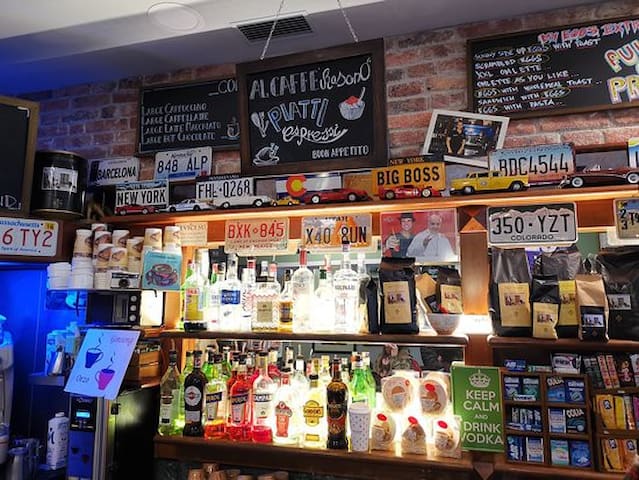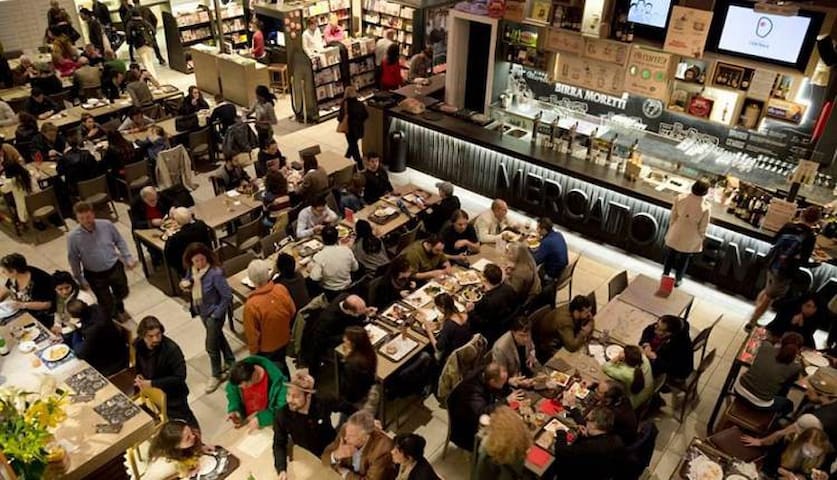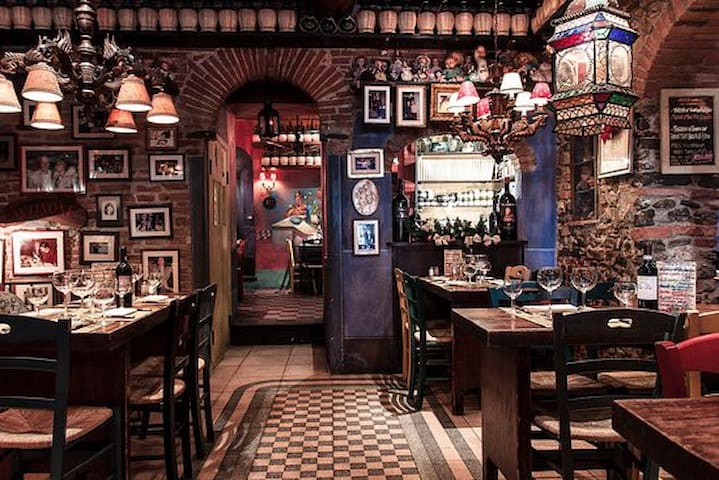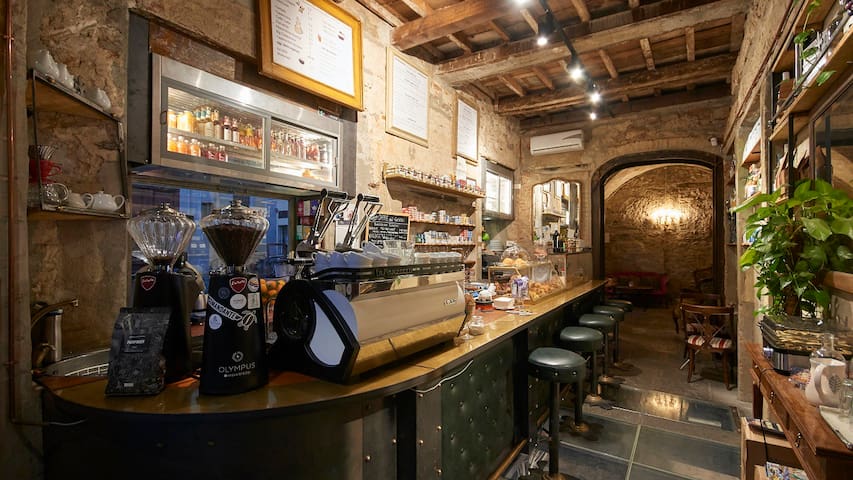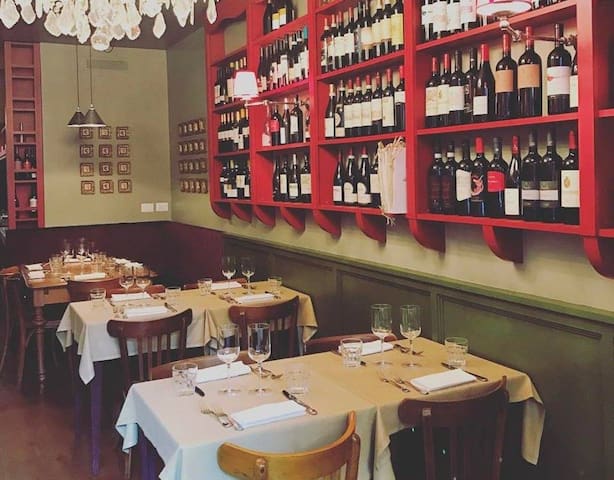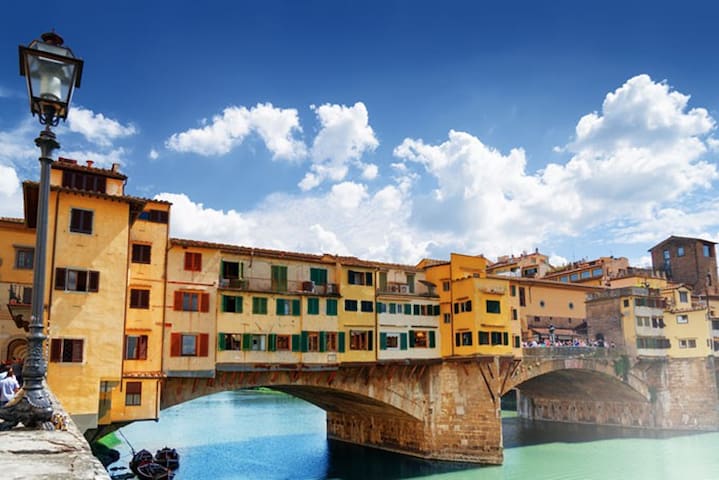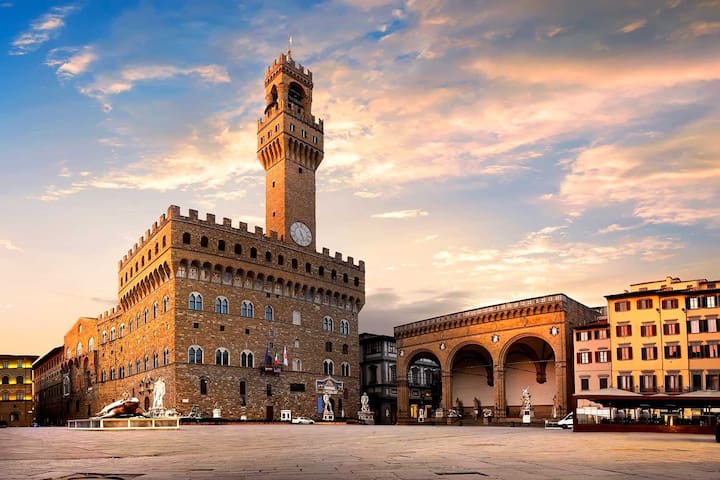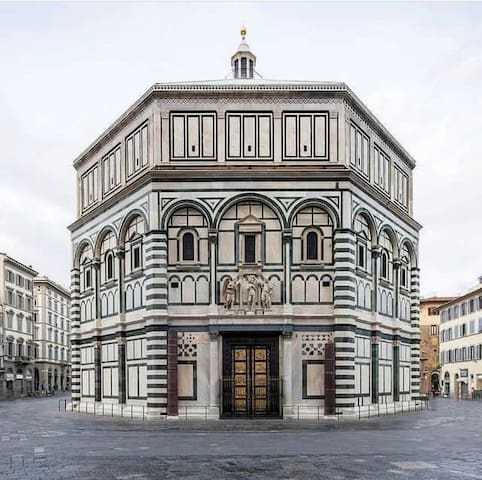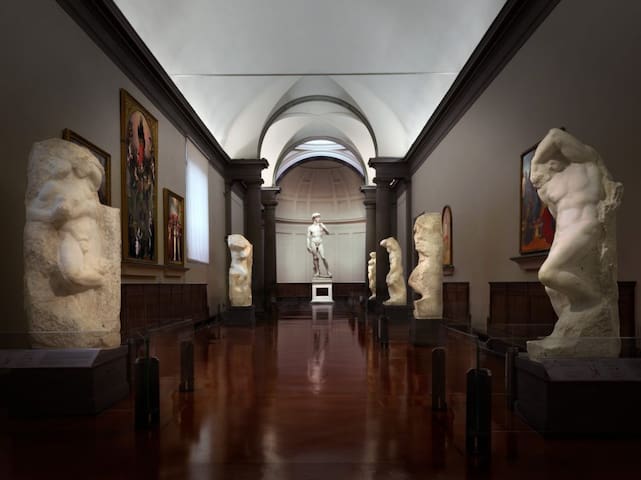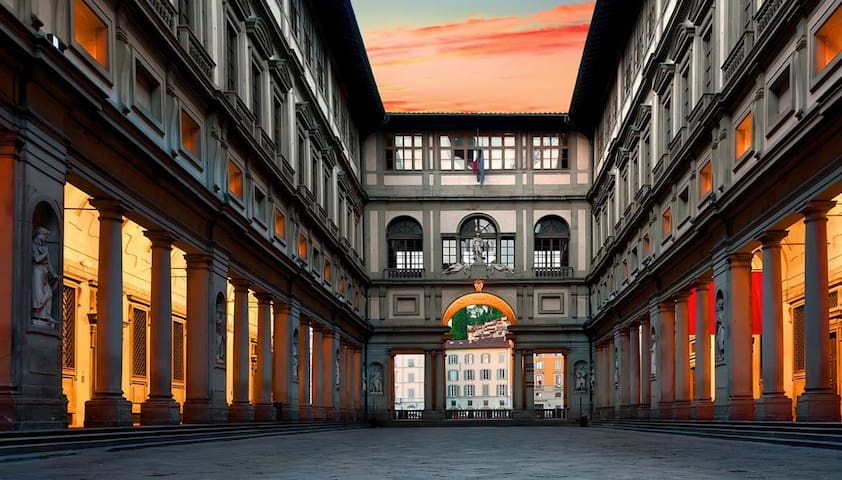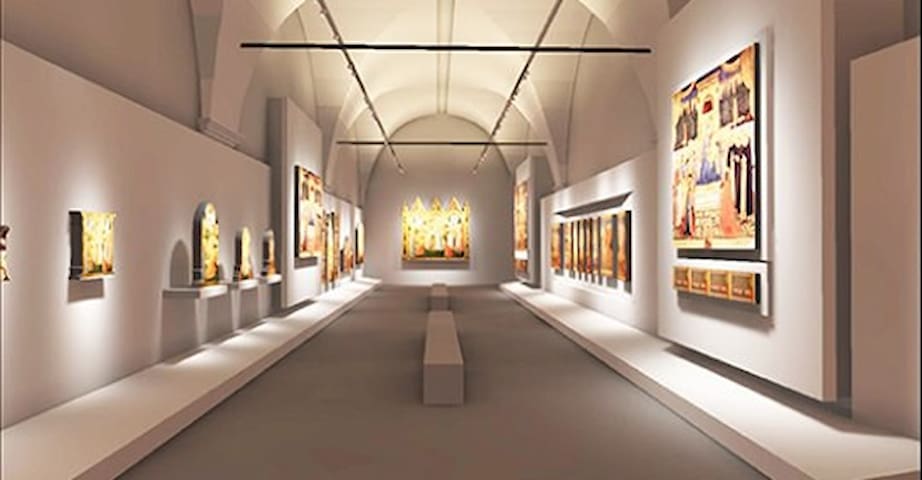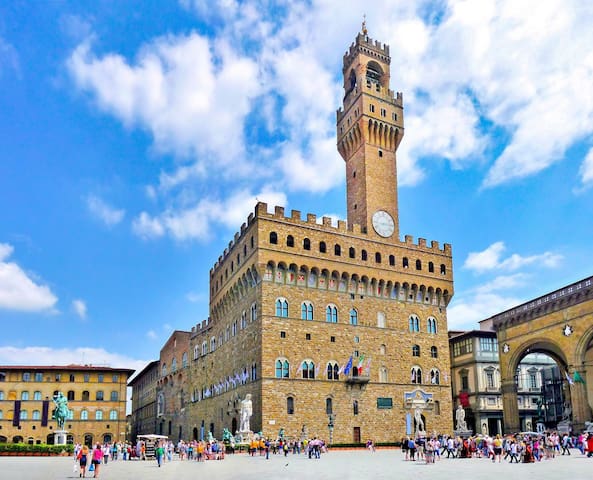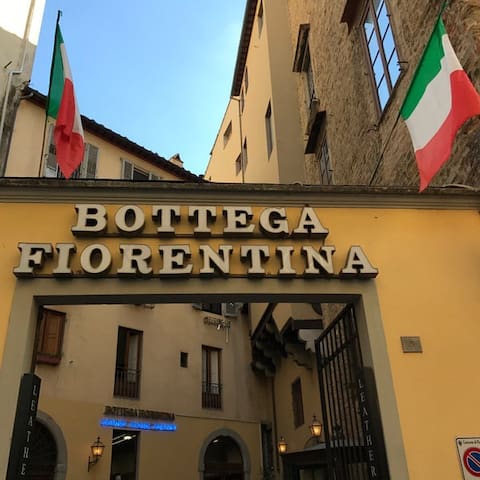Food Scene
In this guide I have selected special places to start discovering the flavors of the food of my city.
Very nice venue indeed, stylish decor and plenty of choice for every palate. Feature cappuccinos of various sizes and special mention for the pistachio croissant: outstanding! Very friendly staff and almost central location.
7 місцеві жителі рекомендують
Caffè Rosanò
29R Via S. GalloVery nice venue indeed, stylish decor and plenty of choice for every palate. Feature cappuccinos of various sizes and special mention for the pistachio croissant: outstanding! Very friendly staff and almost central location.
You can store at all the stores and/or eat the hot and fresh products prepared by the
artisans of taste right on the spot. Each store sells its own products, which you can buy for immediate consumption or take away, paying directly at each artisan's respective cash register. All Market tables are available for you to comfortably consume the dishes purchased at the workshops, at no extra charge.
963 місцеві жителі рекомендують
Меркато Чентрале
Via dell'ArientoYou can store at all the stores and/or eat the hot and fresh products prepared by the
artisans of taste right on the spot. Each store sells its own products, which you can buy for immediate consumption or take away, paying directly at each artisan's respective cash register. All Market tables are available for you to comfortably consume the dishes purchased at the workshops, at no extra charge.
Tuscan cuisine, and Florentine in particular, in this renowned trattoria, with a characteristic setting that overlooks the central market square; the menu is varied and the offer is varied
205 місцеві жителі рекомендують
Trattoria Zà Zà
26r Piazza del Mercato CentraleTuscan cuisine, and Florentine in particular, in this renowned trattoria, with a characteristic setting that overlooks the central market square; the menu is varied and the offer is varied
The perfect brunch in Florence spot to enjoy quality time with friends and even greater quality food.
Rooster Cafe Firenze - Porta Rossa
63R Via Porta RossaThe perfect brunch in Florence spot to enjoy quality time with friends and even greater quality food.
"La Salmoneria" seafood delicatessen has been bringing wild smoked Red King and Sockeye salmon, Norwegian salmon, smoked mackerel and herring, smoked seafood charcuterie, Cantabrian Anchovies, Calvisius Caviar to Florence for years, salmon roe, Sardinian Red Tuna Buggerru, Stefania Calugi's truffle and truffle products, Cetara Armatore anchovies, Borgo del Balsamico condiments, Angiolini chocolate, and many other goodies.
6 місцеві жителі рекомендують
La Salmoneria
4r Piazza del Mercato Centrale"La Salmoneria" seafood delicatessen has been bringing wild smoked Red King and Sockeye salmon, Norwegian salmon, smoked mackerel and herring, smoked seafood charcuterie, Cantabrian Anchovies, Calvisius Caviar to Florence for years, salmon roe, Sardinian Red Tuna Buggerru, Stefania Calugi's truffle and truffle products, Cetara Armatore anchovies, Borgo del Balsamico condiments, Angiolini chocolate, and many other goodies.
SimBIOsi Organic Café is a unique and atmospheric café and wine bar in the heart of old Florence. Inside you will see the original medieval walls of the building, which they have tastefully furnished in contemporary art and vintage chairs and tables.
As the name "SimBIOsi" suggests, it's all about BIO, here you'll find nothing but quality organic and natural products, ranging from specialty coffee to organic food and wine. They carefully pull all espresso with a lever machine on the counter, or if you prefer a slower coffee, they also have a range of other brewing methods.
SimBIOsi Organic Cafe &Lovely Bistro
64r Via de' GinoriSimBIOsi Organic Café is a unique and atmospheric café and wine bar in the heart of old Florence. Inside you will see the original medieval walls of the building, which they have tastefully furnished in contemporary art and vintage chairs and tables.
As the name "SimBIOsi" suggests, it's all about BIO, here you'll find nothing but quality organic and natural products, ranging from specialty coffee to organic food and wine. They carefully pull all espresso with a lever machine on the counter, or if you prefer a slower coffee, they also have a range of other brewing methods.
Right in Florence city center, Osteria Pepò was born from Anna’s and Franco’s passion and love for food.
The history, the tradition and the Tuscan cuisine blend together in a rustic yet refined setting. Pepò is ideal for those of you wanting to experience the genuine Tuscan cuisine and quality food. Pepò offers rustic interiors furnished in a typical Tuscan style where you can breathe an air of an intimate old-style tavern while enjoying specialties of the Tuscan and Florentine tradition. For Florence and the Florentines Pepò is a place where nothing is left to chance: photographs on the walls, wine creates scattered everywhere lend a pleasant and homey feel without giving up a touch of elegance and refinement.
26 місцеві жителі рекомендують
Osteria Pepó
4 Via RosinaRight in Florence city center, Osteria Pepò was born from Anna’s and Franco’s passion and love for food.
The history, the tradition and the Tuscan cuisine blend together in a rustic yet refined setting. Pepò is ideal for those of you wanting to experience the genuine Tuscan cuisine and quality food. Pepò offers rustic interiors furnished in a typical Tuscan style where you can breathe an air of an intimate old-style tavern while enjoying specialties of the Tuscan and Florentine tradition. For Florence and the Florentines Pepò is a place where nothing is left to chance: photographs on the walls, wine creates scattered everywhere lend a pleasant and homey feel without giving up a touch of elegance and refinement.
Pizzeria Starita Firenze
The best Piazza
Sightseeing
An Everlasting Symbol of Florence
Open all of the time, along the pedestrian zone south of Piazza della Repubblica towards Palazzo Pitti. Built very close to the Roman crossing, the Ponte Vecchio, or Old Bridge, was the only bridge across the Arno in Florence until 1218. The current bridge was rebuilt after a flood in 1345. When the Medici moved from Palazzo Vecchio to Palazzo Pitti, they decided they needed a connecting route from the Uffizi to the Palazzo Pitti on the other side of the Arno that would enable them to keep out of contact with the people they ruled. The result was the Corridoio Vasariano, built in 1565 by Giorgio Vasari and which runs above the little goldsmiths' shops on the Ponte Vecchio.
There have been shops on Ponte Vecchio since the 13th century. Initially, there were all types of shops, including butchers and fishmongers and, later, tanners, whose "industrial waste" caused a pretty rank stench in the area. In 1593, Ferdinand I decreed that only goldsmiths and jewelers be allowed to have their shops on the bridge in order to improve the wellbeing of all, including their own as they walked over the bridge.
1339 місцеві жителі рекомендують
Понте Веккіо
Ponte VecchioAn Everlasting Symbol of Florence
Open all of the time, along the pedestrian zone south of Piazza della Repubblica towards Palazzo Pitti. Built very close to the Roman crossing, the Ponte Vecchio, or Old Bridge, was the only bridge across the Arno in Florence until 1218. The current bridge was rebuilt after a flood in 1345. When the Medici moved from Palazzo Vecchio to Palazzo Pitti, they decided they needed a connecting route from the Uffizi to the Palazzo Pitti on the other side of the Arno that would enable them to keep out of contact with the people they ruled. The result was the Corridoio Vasariano, built in 1565 by Giorgio Vasari and which runs above the little goldsmiths' shops on the Ponte Vecchio.
There have been shops on Ponte Vecchio since the 13th century. Initially, there were all types of shops, including butchers and fishmongers and, later, tanners, whose "industrial waste" caused a pretty rank stench in the area. In 1593, Ferdinand I decreed that only goldsmiths and jewelers be allowed to have their shops on the bridge in order to improve the wellbeing of all, including their own as they walked over the bridge.
Symbol of the Florentine Republic
The Piazza della Signoria has been the center of political life in Florence since the 14th century with the prominent Palazzo Vecchio overlooking the square. It was the scene of great triumphs, such as the return of the Medici in 1530 as well as the Bonfire of the Vanities instigated by Savonarola, who was then himself burned at the stake here in 1498 after he was denounced by the Inquisition as a heretic. A marble circle inscription on the piazza shows the location where he was burned.
The sculptures in Piazza della Signoria bristle with political connotations, many of which are fiercely contradictory. The David (the original is in the Galleria dell'Accademia) by Michelangelo was placed outside the Palazzo Vecchio as a symbol of the Republic's defiance of the tyrannical Medici.
557 місцеві жителі рекомендують
П'ятца делла Сіньйорія
Piazza della SignoriaSymbol of the Florentine Republic
The Piazza della Signoria has been the center of political life in Florence since the 14th century with the prominent Palazzo Vecchio overlooking the square. It was the scene of great triumphs, such as the return of the Medici in 1530 as well as the Bonfire of the Vanities instigated by Savonarola, who was then himself burned at the stake here in 1498 after he was denounced by the Inquisition as a heretic. A marble circle inscription on the piazza shows the location where he was burned.
The sculptures in Piazza della Signoria bristle with political connotations, many of which are fiercely contradictory. The David (the original is in the Galleria dell'Accademia) by Michelangelo was placed outside the Palazzo Vecchio as a symbol of the Republic's defiance of the tyrannical Medici.
The Magical Florence Skyline
Florence seen from above is a singular experience. Not just a perfect photo opportunity, but a moment of wonder. You are looking at the city that gave birth to incredible artists, amazing scientists and an enthralling history of discovery and power that has filled novels and movie theaters.
No matter what time of day, you will find that Piazzale Michelangelo truly offers a stupendous lookout over Florence. Don't be surprised if you also see it written as Piazzale Michelangiolo, this is from the archaic Florentine pronunciation and most definitely the one you see on street signs or the brown and white signs that indicate historic landmarks. In any case, however you spell it, it is one site that should not be missed. It may be a classic tourist stop, but it never fails to capture the heart and imagination of those who follow the path to the very top.
1543 місцеві жителі рекомендують
П'ятцале Мікеланджело
Piazzale MichelangeloThe Magical Florence Skyline
Florence seen from above is a singular experience. Not just a perfect photo opportunity, but a moment of wonder. You are looking at the city that gave birth to incredible artists, amazing scientists and an enthralling history of discovery and power that has filled novels and movie theaters.
No matter what time of day, you will find that Piazzale Michelangelo truly offers a stupendous lookout over Florence. Don't be surprised if you also see it written as Piazzale Michelangiolo, this is from the archaic Florentine pronunciation and most definitely the one you see on street signs or the brown and white signs that indicate historic landmarks. In any case, however you spell it, it is one site that should not be missed. It may be a classic tourist stop, but it never fails to capture the heart and imagination of those who follow the path to the very top.
The oldest religious site in all of Florence. Its origins are unknown although it is believed that it was built over the ruins of a Roman temple dedicated to Mars dating back to the 4th-5th century A.D. It was first described in 897 as a minor basilica. In 1128, it was consacrated as the Baptistery of Florence and as such is the oldest religious monument in Florence. Up until the end of the 19th century, all catholics in Florence were baptized within its doors. Today, young children can still be baptized here on the first Sunday of the month, but as they only have space and time for 4, you have to make the request with ample time.
The Baptistery, dedicated to Florence's patron saint, has an octagonal plan and an octagonal lantern with a cupola. Outside it is clad in geometrically patterned colored marble, white Carrara marble and green Prato marble that is typical of Florentine Romanesque architecture.
106 місцеві жителі рекомендують
Хрестильний храм Святого Івана
Piazza San GiovanniThe oldest religious site in all of Florence. Its origins are unknown although it is believed that it was built over the ruins of a Roman temple dedicated to Mars dating back to the 4th-5th century A.D. It was first described in 897 as a minor basilica. In 1128, it was consacrated as the Baptistery of Florence and as such is the oldest religious monument in Florence. Up until the end of the 19th century, all catholics in Florence were baptized within its doors. Today, young children can still be baptized here on the first Sunday of the month, but as they only have space and time for 4, you have to make the request with ample time.
The Baptistery, dedicated to Florence's patron saint, has an octagonal plan and an octagonal lantern with a cupola. Outside it is clad in geometrically patterned colored marble, white Carrara marble and green Prato marble that is typical of Florentine Romanesque architecture.
Florence’s piazza del Duomo is the heart of the city, where in just one glimpse you can instantly admire the main monuments of the historic centre, listed as a UNESCO World Heritage Site. Overlooking the square is the Basilica of Santa Maria del Fiore, originally begun by Arnolfo di Cambio in 1296, and crowned in 1436 by Filippo Brunelleschi’s masterpiece: the Dome. This symbol of Florence is an arduous and majestic structure, from where you can enjoy a fantastic panorama of the city and the cathedral’s interior.
425 місцеві жителі рекомендують
Piazza Delle Pallottole
Piazza delle PallottoleFlorence’s piazza del Duomo is the heart of the city, where in just one glimpse you can instantly admire the main monuments of the historic centre, listed as a UNESCO World Heritage Site. Overlooking the square is the Basilica of Santa Maria del Fiore, originally begun by Arnolfo di Cambio in 1296, and crowned in 1436 by Filippo Brunelleschi’s masterpiece: the Dome. This symbol of Florence is an arduous and majestic structure, from where you can enjoy a fantastic panorama of the city and the cathedral’s interior.
Parks & Nature
Be Prepared to be Wow-ed
A city like Florence, well known for its amazing art collections, monumental architecture and rich historic past can sometimes have you forget about the natural beauty that abounds in the form of well maintained gardens and parks.
The magical silence and stunning architecture in the Bardini Gardens seem to get lost in the crowd of places to visit while in Florence.
Virtually unknown, and many times almost deserted, this 4 hectare garden was recently restored to part of its original glory and is now slowly being rediscovered by the locals and guests to the city of Florence. In an hour you can stroll the entire garden easily and calmly, and that is what this garden deserves: time for a short stroll that will sooth your soul.
339 місцеві жителі рекомендують
Сад Бардині
1 Costa S. GiorgioBe Prepared to be Wow-ed
A city like Florence, well known for its amazing art collections, monumental architecture and rich historic past can sometimes have you forget about the natural beauty that abounds in the form of well maintained gardens and parks.
The magical silence and stunning architecture in the Bardini Gardens seem to get lost in the crowd of places to visit while in Florence.
Virtually unknown, and many times almost deserted, this 4 hectare garden was recently restored to part of its original glory and is now slowly being rediscovered by the locals and guests to the city of Florence. In an hour you can stroll the entire garden easily and calmly, and that is what this garden deserves: time for a short stroll that will sooth your soul.
More than just a garden, it is a place of historical importance for Florence
More than a garden, more than just a “green lung” in Florence, the Boboli gardens are one of the greatest open-air museums in Florence that embraces another site of culture in Florence, the Pitti Palace. The park hosts centuries-old oak trees, sculptures, fountains and offers peaceful shelter from the warm Florentine sun in summer, the beautiful colors of the changing foliage in the fall and smells of blooming flowers in the spring. The Boboli gardens are a spectacular example of "green architecture" decorated with sculptures and the prototype which inspired many European Royal gardens, in particular, Versailles.
1539 місцеві жителі рекомендують
Сади Боболі
1 Piazza de' PittiMore than just a garden, it is a place of historical importance for Florence
More than a garden, more than just a “green lung” in Florence, the Boboli gardens are one of the greatest open-air museums in Florence that embraces another site of culture in Florence, the Pitti Palace. The park hosts centuries-old oak trees, sculptures, fountains and offers peaceful shelter from the warm Florentine sun in summer, the beautiful colors of the changing foliage in the fall and smells of blooming flowers in the spring. The Boboli gardens are a spectacular example of "green architecture" decorated with sculptures and the prototype which inspired many European Royal gardens, in particular, Versailles.
Arts & Culture
The apt is very close at THE GALLERIA OF ACCADEMIA, two minutes by walk, where there is the most famous opera of Michelangelo: the David. The work was assigned to Michelangelo by the workers of the Florence cathedral on 16 August 1501. On 25 January 1504 a commission composed of the prominent artists of the time (among others, Leonardo da Vinci, Sandro Botticelli, Filippino Lippi, the Perugino) decided that the sculpture should have to be placed at the entrance of Palazzo Vecchio, as a symbol of the strength and independence of the Florentines. On 8 September 1504, the statue was unveiled to the city, to the admiration of all people. The Gallery of Accademia it is just along Ricasoli 58/60 street.
The Gallery of accademia open Tuesday through Sunday, 8.15 AM -6.50 PM
From June 4th to September 26th 2019, on tuesday and thursday the Museum will open also in the evening from 7.00 to 10.00 p.m.
Closure: on Mondays, 1 January, 25 December
1077 місцеві жителі рекомендують
Галерея Академії
58 Via RicasoliThe apt is very close at THE GALLERIA OF ACCADEMIA, two minutes by walk, where there is the most famous opera of Michelangelo: the David. The work was assigned to Michelangelo by the workers of the Florence cathedral on 16 August 1501. On 25 January 1504 a commission composed of the prominent artists of the time (among others, Leonardo da Vinci, Sandro Botticelli, Filippino Lippi, the Perugino) decided that the sculpture should have to be placed at the entrance of Palazzo Vecchio, as a symbol of the strength and independence of the Florentines. On 8 September 1504, the statue was unveiled to the city, to the admiration of all people. The Gallery of Accademia it is just along Ricasoli 58/60 street.
The Gallery of accademia open Tuesday through Sunday, 8.15 AM -6.50 PM
From June 4th to September 26th 2019, on tuesday and thursday the Museum will open also in the evening from 7.00 to 10.00 p.m.
Closure: on Mondays, 1 January, 25 December
Journey into beauty through 750 works of art: this is the Opera del Duomo Museum in Florence, where you can admire the largest collection in the world of sculpture from the Middle Ages and the Florentine Renaissance. Here you can find masterpieces by the greatest artists of the time, such as Michelangelo's Pietà Bandini, one of his most mysterious works perhaps destined for the funeral monument of the sculptor, who even tried to destroy it using a hammer. You can also admire the splendid Penitent Magdalene by Donatello, that depicts an elderly and suffering woman with a strikingly tender gaze.
304 місцеві жителі рекомендують
Музей опери Дуомо
9 Piazza del DuomoJourney into beauty through 750 works of art: this is the Opera del Duomo Museum in Florence, where you can admire the largest collection in the world of sculpture from the Middle Ages and the Florentine Renaissance. Here you can find masterpieces by the greatest artists of the time, such as Michelangelo's Pietà Bandini, one of his most mysterious works perhaps destined for the funeral monument of the sculptor, who even tried to destroy it using a hammer. You can also admire the splendid Penitent Magdalene by Donatello, that depicts an elderly and suffering woman with a strikingly tender gaze.
Exploring the glory of masterpieces from the past
Like a very precious treasure chest, the Uffizi Gallery will grant itself to visitors just a little bit at a time: from the initial uncertainty on where to get tickets, getting through lines to get inside and at the metal detector, then taking two flights of Renaissance-era stairs before you arrive at the actual entrance to the museum. Finally, the Gallery unveils its stunning frescoed ceilings and the start of its collections.
The museum is organized as a long labyrinth of rooms with amazing works of art displayed roughly in chronological order along a U-shaped Renaissance building which was never created to be a museum. Cosimo de’ Medici had entrusted his favorite architect Giorgio Vasari to create a grandiose building right next to Palazzo Vecchio, the seat of power, to host the magistrates, the seats of the Florentine Guilds, a vast theatre and judiciary offices (hence the name “Uffizi” which means offices in Italian).
1671 місцеві жителі рекомендують
Галерея Уффіці
6 Piazzale degli UffiziExploring the glory of masterpieces from the past
Like a very precious treasure chest, the Uffizi Gallery will grant itself to visitors just a little bit at a time: from the initial uncertainty on where to get tickets, getting through lines to get inside and at the metal detector, then taking two flights of Renaissance-era stairs before you arrive at the actual entrance to the museum. Finally, the Gallery unveils its stunning frescoed ceilings and the start of its collections.
The museum is organized as a long labyrinth of rooms with amazing works of art displayed roughly in chronological order along a U-shaped Renaissance building which was never created to be a museum. Cosimo de’ Medici had entrusted his favorite architect Giorgio Vasari to create a grandiose building right next to Palazzo Vecchio, the seat of power, to host the magistrates, the seats of the Florentine Guilds, a vast theatre and judiciary offices (hence the name “Uffizi” which means offices in Italian).
The Home of Fra Beato Angelico & Girolamo Savonarola
The Museum of San Marco is worth visiting for its architecture alone. This consists of the former Dominican convent restored and enlarged to its present size for Cosimo the Elder de' Medici by his favorite architect Michelozzo (1396-1472). Consecrated in 1443, this building was the scene of fervent religious activity, highlighted by personalities such as St. Antonino Pierozzi, Bishop of Florence, the Beato Angelico (c.1400-1450) and, later, Girolamo Savonarola.
The museum offers the visitor an example of a perfectly preserved fifteenth century convent, its rational and harmonious plan based on Brunelleschi's innovations. Everything is designed to coordinate and simplify the monastic life within its walls as much in its calm cloister as in the light-filled library, one of the finest interiors of the Renaissance.
On the other hand, the complex also contains the museum of Fra' Angelico's works in the form of frescoed interiors and the panels displayed in the large alms-house. Among the first series, the most famous is the Crucifixion painted in the Chapter House, permeated by the contemplative melancholy found in the refined spirituality of the Dominicans; in the cells, austere yet full of meditative inspiration for the brethren, are the Annunciation, the Three Marys at the Tomb, Noli me tangere and others.
125 місцеві жителі рекомендують
Музей Сан-Марко
3 Piazza San MarcoThe Home of Fra Beato Angelico & Girolamo Savonarola
The Museum of San Marco is worth visiting for its architecture alone. This consists of the former Dominican convent restored and enlarged to its present size for Cosimo the Elder de' Medici by his favorite architect Michelozzo (1396-1472). Consecrated in 1443, this building was the scene of fervent religious activity, highlighted by personalities such as St. Antonino Pierozzi, Bishop of Florence, the Beato Angelico (c.1400-1450) and, later, Girolamo Savonarola.
The museum offers the visitor an example of a perfectly preserved fifteenth century convent, its rational and harmonious plan based on Brunelleschi's innovations. Everything is designed to coordinate and simplify the monastic life within its walls as much in its calm cloister as in the light-filled library, one of the finest interiors of the Renaissance.
On the other hand, the complex also contains the museum of Fra' Angelico's works in the form of frescoed interiors and the panels displayed in the large alms-house. Among the first series, the most famous is the Crucifixion painted in the Chapter House, permeated by the contemplative melancholy found in the refined spirituality of the Dominicans; in the cells, austere yet full of meditative inspiration for the brethren, are the Annunciation, the Three Marys at the Tomb, Noli me tangere and others.
The basilica of San Lorenzo in Florence was built in the 4th century and was originally dedicated to Saint Ambrogio. It was renovated in the Romanesque period, in 1059, and then rebuilt in the 15th century following a design by Filippo Brunelleschi under the patronage of the Medici family.
The Basilica was completed by his heir, Antonio Manetti, in 1461 and still today the church has preserved the harmony and perfect proportions desired by Brunelleschi.
Michelangelo would have had to finish the façade with marble, but the project wanted by Pope Leo X never started.
The Basilica preserves wonderful works of art, such as the 15th-century Old Sacristy of Filippo Brunelleschi, where you can admire the friezes with the episodes of San Giovanni Evangelista's life made by Donatello, who made also the bronze doors (15th century), the Pulpit of the Resurrection and Pulpit of the Pass.
205 місцеві жителі рекомендують
Базиліка Сан-Лоренцо
9 Piazza di San LorenzoThe basilica of San Lorenzo in Florence was built in the 4th century and was originally dedicated to Saint Ambrogio. It was renovated in the Romanesque period, in 1059, and then rebuilt in the 15th century following a design by Filippo Brunelleschi under the patronage of the Medici family.
The Basilica was completed by his heir, Antonio Manetti, in 1461 and still today the church has preserved the harmony and perfect proportions desired by Brunelleschi.
Michelangelo would have had to finish the façade with marble, but the project wanted by Pope Leo X never started.
The Basilica preserves wonderful works of art, such as the 15th-century Old Sacristy of Filippo Brunelleschi, where you can admire the friezes with the episodes of San Giovanni Evangelista's life made by Donatello, who made also the bronze doors (15th century), the Pulpit of the Resurrection and Pulpit of the Pass.
Santa Maria del Fiore, designed by Arnolfo di Cambio, is the third largest church in the world (after St. Peter's in Rome and St. Paul's in London) and was the largest church in Europe when it was completed in the 15th century. It is 153 metres long, 90 metres wide at the crossing, and 90 metres high from the floor to the bottom of the lantern. The third and last cathedral of Florence, it was dedicated to Santa Maria del Fiore, the Virgin of the Flower, in 1412, a clear allusion to the lily, the symbol of the city of Florence.
The numerous different styles that we encounter in the building bear witness to changing tastes over the long period of time that elapsed between its foundation and its completion.
1085 місцеві жителі рекомендують
Катедра Санта-Марія-дель-Фьоре
Piazza del DuomoSanta Maria del Fiore, designed by Arnolfo di Cambio, is the third largest church in the world (after St. Peter's in Rome and St. Paul's in London) and was the largest church in Europe when it was completed in the 15th century. It is 153 metres long, 90 metres wide at the crossing, and 90 metres high from the floor to the bottom of the lantern. The third and last cathedral of Florence, it was dedicated to Santa Maria del Fiore, the Virgin of the Flower, in 1412, a clear allusion to the lily, the symbol of the city of Florence.
The numerous different styles that we encounter in the building bear witness to changing tastes over the long period of time that elapsed between its foundation and its completion.
Palazzo Vecchio is the main symbol of civil power for the city of Florence, whose original project is attributed to Arnolfo di Cambio. Construction on the solid fortress began in 1299 above the ruins of the destroyed Uberti Ghibelline towers, testimony of the final victory of the Guelph faction. From the very beginning, the main section of Palazzo Vecchio was destined to host the city council which was composed of chief members the Guilds of Florence (the Priori) who governed the Republic of Florence. In 1342, the Duke of Athens, Walter VI of Brienne, enlarged Palazzo della Signoria towards Via della Ninna, giving it the appearance of a fortress and even adding a secret staircase for nightly exits. The severe medieval architecture conceals sumptuous halls and residential apartments. Palazzo Vecchio's current appearance is due largely to great works of renovation and interior decoration that were made around 1540, when Duke Cosimo I de’ Medici and his wife Eleonora of Toledo decided to turn the palace into their residence. The court of the Medici was transferred to Palazzo Vecchio (from Palazzo Medici-Riccardi), which was transformed into a fascinating labyrinth of institutional chambers, apartments, terraces and courtyards. All the rooms (the so-called Quartieri Monumentali) are magnificently decorated by artists such as Michelangelo, Giorgio Vasari and Donatello.
710 місцеві жителі рекомендують
Palazzo Vecchio
Piazza della SignoriaPalazzo Vecchio is the main symbol of civil power for the city of Florence, whose original project is attributed to Arnolfo di Cambio. Construction on the solid fortress began in 1299 above the ruins of the destroyed Uberti Ghibelline towers, testimony of the final victory of the Guelph faction. From the very beginning, the main section of Palazzo Vecchio was destined to host the city council which was composed of chief members the Guilds of Florence (the Priori) who governed the Republic of Florence. In 1342, the Duke of Athens, Walter VI of Brienne, enlarged Palazzo della Signoria towards Via della Ninna, giving it the appearance of a fortress and even adding a secret staircase for nightly exits. The severe medieval architecture conceals sumptuous halls and residential apartments. Palazzo Vecchio's current appearance is due largely to great works of renovation and interior decoration that were made around 1540, when Duke Cosimo I de’ Medici and his wife Eleonora of Toledo decided to turn the palace into their residence. The court of the Medici was transferred to Palazzo Vecchio (from Palazzo Medici-Riccardi), which was transformed into a fascinating labyrinth of institutional chambers, apartments, terraces and courtyards. All the rooms (the so-called Quartieri Monumentali) are magnificently decorated by artists such as Michelangelo, Giorgio Vasari and Donatello.
Shopping
In the heart of Florence at the intersection of via Porta Rossa and via Calimala (which already becomes Por Santa Maria and flows into Ponte Vecchio) there is the loggia of the Mercato Nuovo where the very famous Porcellino market is held every day. Under the loggia they sell handcrafted leather products made in Tuscany , fine articles of Italian silk and scarves , embroidered tapestries , tourist sweaters and souvenirs .
7 місцеві жителі рекомендують
Лоджія дель Меркато Нуово
Piazza del Mercato NuovoIn the heart of Florence at the intersection of via Porta Rossa and via Calimala (which already becomes Por Santa Maria and flows into Ponte Vecchio) there is the loggia of the Mercato Nuovo where the very famous Porcellino market is held every day. Under the loggia they sell handcrafted leather products made in Tuscany , fine articles of Italian silk and scarves , embroidered tapestries , tourist sweaters and souvenirs .
The shop is huge with a wide variety of items: wallets, bags, belts, etc. The quality is good.
Bottega Fiorentina
5 Borgo dei GreciThe shop is huge with a wide variety of items: wallets, bags, belts, etc. The quality is good.
Essentials
Two minutes from the apartment you will find a supermarket, "Carrefour", where you will find all the basic necessities. Supermarket Carrefour open 7 days a week, 9 am to 9 pm, 50 it is just along dè Ginori street
Carrefour Express
66 Via dell' OriuoloVia de' Ginori, 41, 50123 Firenze FI
Hours: 08-23

